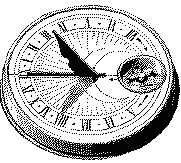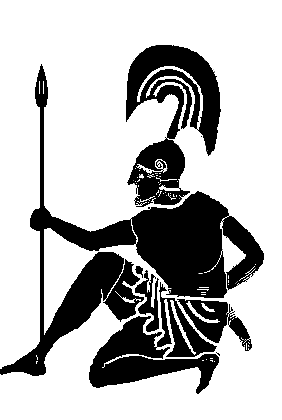

Around 500 BC, there was a Greek philosopher named Zeno. You've probably heard of him, or at least of the dilemma he raised. He stated it in a number of different ways, but I shall concentrate on just one.
 |
 |
 |
The hero, Achilles, and the tortoise agree to a foot race. The tortoise complains that Achilles has the gift of speed, but alas he, the tortoise, does not. So he petitions Achilles for a handicap. And Achilles agrees to allow the tortoise a 1000 meter head start. Surely, Achilles thinks to himself, I can still win this race.
Now Achilles certainly does have the gift of speed and can do a steady 5 meters per second without even breaking a sweat. So that is how fast Achilles decides to run. But the poor tortoise redlines at just half a meter per second. And knowing that he'll have to do his very best even to have a chance against the speedster, Achilles, he must go just as fast has he can go.
The starting signal sounds precisely at noon. The problem is to figure out exactly what time Achilles passes the tortoise.
Well, a little elementary algebra quickly gives us an answer. If xA is where Achilles is, xT is where the tortoise is, and t is seconds past noon, we have the following equations:
æ 1 meters ö
xT = 1000 meters + ç t ÷ equation of the tortoise
è 2 second ø
eq. 2.0-1
æ meters ö
xA = 0 meters + ç 5 t ÷ equation of Achilles
è second ø
Since Achilles and the tortoise must be in exactly the same spot when one passes the other, we solve for xA = xT. This being the case, we can subtract the two equations above to get:
æ 1 meters ö
0 = 1000 meters - ç 4 t ÷ eq 2.0-2
è 2 second ø
2
t = 222 seconds
9
Zeno probably also had the algebraic wherewithall to solve the problem in a similar way. But he observed that after 200 seconds, Achilles runs the 1000 meter distance of the tortoise's head start. At that time he is where the tortoise started. But in that amount of time, the tortoise has run 100 meters. So 20 seconds later (that is at t = 220 seconds) Achilles catches up to that spot. But in those 20 seconds, the tortoise has run another 10 meters. It takes Achilles only 2 seconds to catch up to that spot. But by then, the tortoise has run another meter. Zeno realized that this process goes on forever, with Achilles always catching up to where the tortoise was, and the tortoise always running a little bit farther. So how can Achilles ever pass the tortoise?
We actually have several examples of things that tend to a limit in this parable. We have the sequence of times, t1, t2, t3, etc. At each tj Achilles is where the tortoise was at tj-1. That defines all the tj's except t1, which we will say is the moment of the starting signal. So the various tj's are:
t1 = 0 seconds eq. 2.0-3
t2 = 200 seconds
t3 = 220 seconds
t4 = 222 seconds
t5 = 222.2 seconds
t6 = 222.22 seconds
.
.
.
I'm sure you can see the pattern here, but can you prove it? Yes, you can, and you're going to do so right now.
(Think back to how you solved rate
problems in algebra. Remember that
By what factor does Achilles' speed exceed the tortoise's? Get that by dividing the tortoise's speed into Achille's speed. Call that number r for ratio. Now, if it takes the tortoise an amount of time, Dt, to run some distance, how long does it take Achilles to run that same distance ? Get that by dividing Dt by r. Why? (refer to the rate formula given above).
Don't let the Dt (that is pronounced, "Delta-Tee") throw you. The D just means "difference." So Dt just means the difference between to t's.
Now observe that during each interval, Achilles runs the same distance that the tortoise ran in the previous interval. Here is the pattern of the intervals, which we call delta_t's:
Dt1 = t2 - t1 = 200 seconds - 0 seconds = 200 seconds Dt2 = t3 - t2 = 220 seconds - 200 seconds = 20 seconds Dt3 = t4 - t3 = 222 seconds - 220 seconds = 2 seconds . . . eq. 2.0-4Notice that the Dt's go down by a factor of 10 each time. Why? Well, you arrived at
We already know that Achilles passes the tortoise at
2
t = 222 seconds eq. 2.0-5
9
from the algebra we did before. Can we show that the sequence of
tj's has this as its limit? Well, what do we have to show? We
have to show that if I tell you how close you want tj to be to
the t we gave above, then you can tell me how far into the sequence
of tj's I have to go in order to assure me that all the
tj's that
follow are at least that close.
You instructor will word it in a different way. He or she will say,
"given any e greater than zero, you need to be able to
find an n
big enough so that
Don't let the Greek symbol or the mathematical formalism intimidate you. The statement of the problem I gave means precisely the same thing as the one your instructor gives. A limit means simply, I tell you how close I need to be, and you can tell me what I have to do to be that close. In the formal version of this, e (that's Greek letter, epsilon) is the "how close I gotta be" and n is the "what I gotta do to be that close."
If I say, for example, I've got to be within a thousandth of a second
of t (i.e.
But so far we haven't proved the assertion. To prove it, we must show that we can always find how far to go no matter how close we have to be. Let's do that now.
We can see that the jth term of the sequence given in 2.0-3
is a bunch of 2's, beginning in the hundreds column and extending
rightward. There are always j-1 2's in each decimal. So we can
easily write the decimal for any term in the series. The 13th, for
example, is:
It's pretty clear that after t3 all the tj's are within 1 of 222. So all we will prove is that the fractional part of the sequence (that is the part to the right of the decimal point) converges to a limit of 2/9.
So let's find the difference between a bunch of 2's to the right of the decimal point and 2/9. Recall that if we have n 2's to the right of the decimal point, what we really have is the counting number made of n digits of 2's divided by 10n. So, for example, nine 2's to the right of the decimal point means:
222222222
0.222222222 = eq. 2.0-6
109
So, in the example where n=9, we are interested in:
ç 2 222222222 ÷
e = ç - ÷ eq. 2.0-7
ç 9 109 ÷
e represents how close we are to the limit.
We have to put these fractions over a common denominator in order to subract them. So to the right-hand one we have to multiply top and bottom by 9. To the left-hand one we have to multiply top and bottom by 109. We get:
ç 2000000000 1999999998 ÷ 2
e = ç - ÷ = eq. 2.0-8
ç 9000000000 9000000000 ÷ 9000000000
In fact, when you multiplied those nine 2's by 9, it became
pretty clear that there is a pattern there. And if you multiply n 2's
by 9, what you will always get is a 1 followed by
n-1 9's, followed by an 8. And when you subtract that from
2 × 10n, you will always get 2. So that will
always be the numerator of the difference. And the denominator? Clearly
it will always be 9 × 10n. So for a decimal point
followed by n 2's, we have:
2
e = eq. 2.0-9
9×10n
So, can you make e as close to zero as you like by choosing
the right n? and does e stay at least that close
for all subsequent n? The answer is clearly yes, because the
numerator doesn't change as n gets big, but the denominator keeps
getting more and more huge.
Well we have diverged a long way from the foot race. So what have we proved?
We have proved that the sequence of times, tj, does
indeed converge to a limit, and that limit is the same time that we predicted
earlier, using algebra, that Achilles should be passing the tortoise. We can
tell Mr. Zeno that even if he can never see how Achilles gets to
And since we know that Achilles does indeed pass the tortoise, our notion of a limit bears a true connection to reality. Zeno's dilemma was that the sequence of times leading up to the passing represented a completed infinite, yet the infinite is defined as that which never ends. Zeno's problem was that he had a poor definition of "infinite." Infinites do end all the time. And they end in a limit.
Section 2.1: How Close to the Edge Dare You Go?